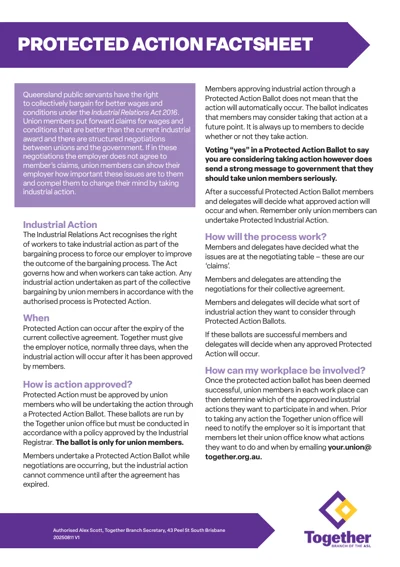Protected Action can occur after the expiry of the current collective agreement. Together must give the employer notice, normally three days, when the industrial action will occur after it has been approved by members.

When union members act together, we make change happen.
Protected industrial action puts real pressure on the department and pushes negotiations forward.
Only union members can take protected action.
What is protected action?
Queensland public servants have the right to collectively bargain for better wages and conditions under the Industrial Relations Act 2016. Union members put forward claims for wages and conditions that are better than the current industrial award and there are structured negotiations between unions and the department. If in these negotiations the employer does not agree to member’s claims, union members can show their employer how important these issues are to them and compel them to change their mind by taking industrial action.
The Industrial Relations Act recognises the right of workers to take industrial action as part of the bargaining process to force our employer to improve the outcome of the bargaining process. The Act governs how and when workers can take action. Any industrial action undertaken as part of the collective bargaining by union members in accordance with the authorised process is Protected Action.
Protected Action must be approved by union members who will be undertaking the action through a Protected Action Ballot. These ballots are run by the Together union office but must be conducted in accordance with a policy approved by the Industrial Registrar. The ballot is only for union members. Members undertake a Protected Action Ballot while negotiations are occurring, but the industrial action cannot commence until after the agreement has expired.
Members approving industrial action through a Protected Action Ballot does not mean that the action will automatically occur. The ballot indicates that members may consider taking that action at a future point. It is always up to members to decide whether or not they take action. Voting “yes” in a Protected Action Ballot to say you are considering taking action however does send a strong message to government that they should take union members seriously. After a successful Protected Action Ballot members and delegates will decide what approved action will occur and when. Remember only union members can undertake Protected Industrial Action.
Members approving industrial action through a Protected Action Ballot does not mean that the action will automatically occur. The ballot indicates that members may consider taking that action at a future point. It is always up to members to decide whether or not they take action. Voting “yes” in a Protected Action Ballot to say you are considering taking action however does send a strong message to government that they should take union members seriously. After a successful Protected Action Ballot members and delegates will decide what approved action will occur and when. Remember only union members can undertake Protected Industrial Action.
Members and delegates have decided what the issues are at the negotiating table – these are our ‘claims’. Members and delegates are attending the negotiations for their collective agreement. Members and delegates will decide what sort of industrial action they want to consider through Protected Action Ballots. If these ballots are successful members and delegates will decide when any approved Protected Action will occur.
Once the protected action ballot has been deemed successful, union members in each work place can then determine which of the approved industrial actions they want to participate in and when. Prior to taking any action the Together union office will need to notify the employer so it is important that members let their union office know what actions they want to do and when by emailing your.union@ together.org.au.
How a Protected Action Ballot Works
Protected industrial action is one of the most powerful tools union members have to secure fair outcomes in bargaining. To take this kind of action, we must first follow a legal process that starts with a Protected Action Ballot (PAB).
A PAB is a formal vote of union members to decide what types of industrial action they are willing to take and when. This process is not just a formality—it’s an opportunity for members to show unity, and send a strong message to the employer that we are serious about winning a better deal.
Below is an outline of each step in the process, from identifying the actions to taking them, so you know exactly how it works and how you can be involved every step of the way.
Before we can take protected industrial action, there are important steps to prepare and make sure every member has their say. Sometimes voting in a Ballot and getting ready moves the employer at negotiations enough, and you won’t need to take action.
Step 1:Each Protected Action Ballot can consider a range of industrial actions for members to approve. Through discussions with union members and delegates, we will be able to identify what this range of actions will be. At any stage, if members want to know what action to consider or to get some advice on the process, email your.union@together.org.au
Step 2: Only union members get to vote in the protected action ballot and only union members can take the action, so it is important that union members are talking with their colleagues about becoming members so they can also vote and participate in this important step.
Step 3: Members will receive an email from the Together Office advising them that a Protected Action Ballot is about to commence. Make sure you talk about this in the workplace so any members who did not get the email can contact the Together Office to update their details and make sure they are included in the Protected Action Ballot. In some cases the Together Office may ring or SMS members to let them know that a Protected Action Ballot is about to occur.
Step 4: Members will receive an email from BigPulse (a secure online voting platform) asking them to approve or oppose the industrial action as part of a Protected Action Ballot. Any members who join after the Protected Action Ballot opens will be sent an email allowing them to have their say on the proposed action. The Together Office may also call and SMS members to remind them to participate in the ballot. In some cases, the Protected Action Ballot might be conducted through an alternative to email process.
After a successful Protected Action Ballot, members and delegates will decide what approved industrial action will occur and when. Members will then be advised of the timing, and the action will commence. Only union members can take part in Protected Industrial Action. Some actions may run for a set period, while others may continue until members choose to stop or an in-principle agreement is reached in collective bargaining.
Members will commence the industrial action. Only union members may participate in the Protected Industrial Action. Some industrial action may have a limited timeframe, and other action might be of an ongoing nature. Ongoing industrial action finishes when members determine to stop the action or when an in-principle agreement has been reached in the collective bargaining negotiations.

